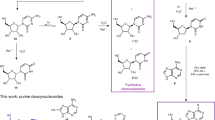Abstract
Reciprocal hybridizations were carried out between DNA fromPseudomonas fluorescens, P. putida and a xanthomonad,P. campestris var.pelargonii. Furthermore, DNA-fragments from each organism, preselected by hybridization with each of the other two strains, were again hybridized with all three DNA-types. The molecular weight of the chromosomal DNA from the three organisms is about equal, having a value of 2.4·0.4×109 daltons/nucleoid or 3.9 × 106 nucleotide pairs/nucleoid. About half of the DNA from each organism has a similar, but not identical, nucleotide sequence. Theputida- andfluorescens-DNA share an additional 33°. homology. From the present and previous experiments it can be hypothesized that all xanthomonads share an additional stretch of homologous DNA, amounting to some 25–40% of the bacterial chromosome. The remaining DNA in each organism (about 15%) is probably responsible for strain individuality (varieties, races and strains within the same genospecies). The results suggest that the three organisms are derived from a common pool of ancestors; that the xanthomonads diverged first or fastest and that the split betweenP. putida andP. fluorescens is a more recent event. The mean molar (guanine + cytosine) content of the common part is identical to that of the total parent DNA. The average value for the three organisms is 62·2% (G+C). The direction of the evolutionary drift of the (G+C) content between these closely related organisms is not detectable.
Similar content being viewed by others
References
Berns, K. I. andThomas, C. A., Jr. 1965. Isolation of high molecular weight DNA fromHemophilus influenzae. J. Mol. Biol.11 476–490.
Bolton, E. T., Britten, R. J., Byers, T. J., Cowte, D. B., Hoyer, B., Kato, Y., McCarthy, B. J., Mirand, M. andRoberts, R. B. 1963–64. Carnegie Institution, Annual Report. p. 366–397.
Cairns, J. 1963. The chromosome ofEscherichia coli. Cold Spring Harbor Symp. Quant. Biol.28 43–45.
De Ley, J. andFriedman, S. 1964. Deoxyribonucleic acid hybrids of acetic acid bacteria. J. Bacteriol.88 937–945.
De Ley, J. andFriedman, S. 1965. Similarity ofXanthomonas andPseudomonas deoxyribonucleic acid. J. Bacteriol89 1306–1309.
De Ley, J. Park, I. W., Tutgat, R. andVan Ermengem, J. 1966. DNA homology and taxonomy ofPseudomonas andXanthomonas. J. Gen. Microbiol.42 43–56.
De Ley, J. andSchell, J. 1963. Deoxyribonucleic acid base composition of acetic acid bacteria. J. Gen. Microbiol.33 243–253.
Dennis, E. S. andWake, R. G. 1966. Autoradiography of theBacillus subtilis chromosome. J. Mol. Biol.15 435–439.
Freese, E. 1962. On the evolution of the base composition of DNA. J. Theoret. Biol.3 81–101.
Holloway, B. W. andFargie, B. 1960. Fertility factors and genetic linkage inPseudomonas aeruginosa. J. Bacteriol.80 362–368.
Jesse, O. 1965.Pseudomonas aeruginosa and other green fluorescent pseudomonads. Munksgaard, Copenhague.
Lysenko, O. 1961.Pseudomonas — an attempt at a general classification. J. Gen. Microbiol.25 379–408.
McCarthy, B. J. andBolton, E. T. 1963. An approach to the measurement of genetic relatedness among organisms. Proc. Natl. Acad. Sci. U.S.50 156–162.
Mandel, M. 1966. Deoxyribonucleic acid base composition in the genusPseudomonas. J. Gen. Microbiol.43 273–292.
Massie, H. R. andZimm, B. H. 1965. Molecular weight of the DNA in the chromosomes ofE. coli andB. subtilis. Proc. Natl. Acad. Sci. U.S.54 1636–1641.
Morowitz, H. J., Tourtellotte, M. E., Guild, W. R., Castro, E., Woese, C. andClfverdon, R. C. 1962. The chemical composition and submicroscopic morphology ofMycoplasma gallisepticum, avian PPLO 5969. J. Mol. Biol.4 93–103.
Smith, A. G. 1950. Electron and light microscopic studies of bacterial nucleic. J. Bacteriol.59 575–587.
Sufoka, N. 1962. On the genetic basis of variation and heterogeneity of DNA base composition. Proc. Natl. Acad. Sci. U.S.48 582–592.
Author information
Authors and Affiliations
Rights and permissions
About this article
Cite this article
Park, I.W., De Ley, J. Ancestral remnants in deoxyribonucleic acid fromPseudomonas andXanthomonas . Antonie van Leeuwenhoek 33, 1–16 (1967). https://doi.org/10.1007/BF02045528
Received:
Issue Date:
DOI: https://doi.org/10.1007/BF02045528




